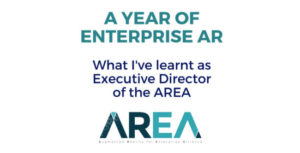What I’ve Learnt as Executive Director of the AREA
I’ve had the most amazing year as Executive Director of the Augmented Reality Enterprise Alliance (AREA). Getting to really understand this new and amazing Enterprise AR ecosystem has been a fantastic journey.
I’ve spoken to many enterprise executives and innovation leaders who are looking to improve their companies’ performance and create efficiencies. There have been many conversations with providers of AR technology (including a growing number of startups focusing on AR) that are offering innovative solutions. I have also gained insight from numerous non-commercial organisations – from governments to universities and research institutes. All which has enabled me to gain a wide and comprehensive view of the Enterprise AR ecosystem.

So, what have I learnt in my first year?
When I started back in May 2016, I would have said that the Enterprise AR ecosystem was very “irregular” because of the following characteristics:
- Enterprises were uncertain about which AR areas to invest in
- Providers were unable to find customers
- Technology readiness was unclear
- Best use cases were still being defined
- Efficiencies were difficult to achieve
What a difference a year has made. The ecosystem is moving forward rapidly, with more enterprises and providers understanding AR, developing focused solutions, providing more clarity on best practices and creating better tools.
Equally important, “AR language” is now being shared with key business decision makers (CEO, CIO, CTO). They are beginning to understand the benefits and challenges for the ecosystem.
But issues remain. Enterprise AR is still not a mainstream technology, performance improvements are not being realised across entire organisations, and many projects are stuck in the prototyping / testing phase.
With the help and insight of the AREA members, we have spent the past 12 months understanding what needs to be done to move from the “in prototype” phase to “full deployment” stage so that enterprises can gain the benefits and return on investment from AR.
The AREA Portal – your one-stop shop for neutral Enterprise AR information
The challenge is multi-layered and goes beyond just technology readiness! That’s why the AREA has continued to create initiatives to help enterprises. We are investing in updating the AREA portal and building a “one-stop shop” for Enterprise AR information – from AR use cases, case studies, and technology white papers, to the latest thought leadership articles, news stories, and events. It’s important to build a set of vendor-neutral information that can help executives make informed decisions. We are also working on creating more neutral ROI analysis and looking for enterprises and providers to help share any ROI information they have.
AREA research capability
We are also building up the AREA research capability. We have asked members what should be researched to help the growth of the Enterprise AR ecosystem and in 2016 we commissioned research on security in wearables. The report(s) are just about to be realised and will provide the AREA members with the following insightful and useful research:
Report 1 – Wearable Enterprise AR Data Security Risks and Management
This report will allow AREA members to better understand data security risks, communicate using a common vocabulary, characterize threats via a structured framework, assess major vulnerabilities against that framework, and identify key metrics to measure risks in the real world.
Report 2 – Wearable Enterprise AR Security – Framework and Test Protocol
This report proposes a security framework for AR developers and enterprise practitioners. It explains how to create a three-phase test protocol for evaluation of AR headset solutions:
- Identify appropriate security requirements for the AR device in an enterprise project
- Evaluate the security design of the AR device using vendor and third-party data
- Test the AR device security as part of the enterprise project
These reports are only available to AREA members. If you are not a member yet, please contact me if you are interested in joining.
We have also kicked off the next phase of research proposals to find out what the members would like to research next!
Global AR requirements
Another identified gap is a lack of Enterprise AR requirements. Having those requirements would help enterprises create standard RFP / RFI’s for AR solutions. For their part, providers would find the requirements useful to helping them develop their product roadmaps, as well as encouraging interoperability of software and hardware.
It was exciting and inspiring to run the first global AR requirements meeting with the DMDII in Chicago (1st / 2nd March) with 65 companies and 90 people discussing the draft AR enterprise requirements (created by Lockheed Martin, Caterpillar and Procter and Gamble). The AREA is planning to run another session in Oct ’17. I’m looking forward to again engaging directly with the ecosystem.
AR Safety Committee
Safety is a concern for all enterprises and the use of AR (particularly with wearables) is one area that needs to be carefully considered when rolling out an AR solution to the wider workforce.
A new AREA charter is being created to bring together interested members to help define and provide insight into the potential problem. More to follow in H2 2017.
Much more to come – together
It’s been an amazing first year for me at the AREA – engaging with practitioners from all over the world who want to drive change, improve performance, and deliver valuable Enterprise AR services.
But it’s clear that work still needs to be done. The AREA will continue to help drive the ecosystem, to provide a place to discuss and solve the wider problems, to help enterprises and providers to work together, to make a difference, and to accelerate the adoption of Enterprise AR.
There is an African proverb I often like to cite: “If you want to go quickly, go alone. If you want to go far, go together.”
Please join me and over 30 organisations in working to ensure that AR technology creates lasting benefits for the world.








